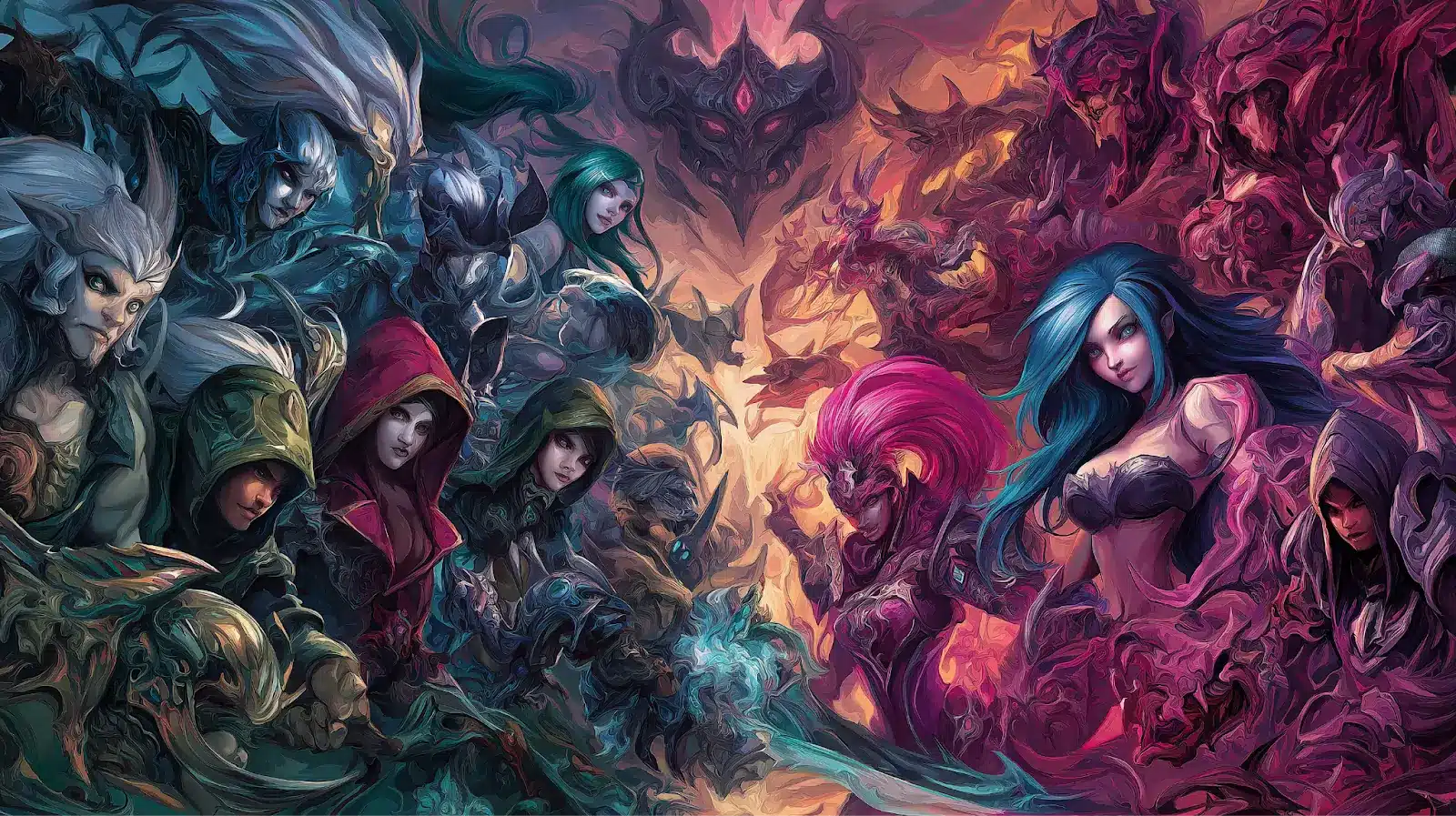Welcome! Get hyped, mid-laners! You’re about to unlock the secret mechanics that separate the “I barely win” crowd from the “I steamroll everyone” squad. If you’ve ever felt like you’re one misclick away from disaster—spamming spells with no impact, getting outplayed in trades, or tilting so hard you forget how to CS—this is your wake-up call.
We’re diving deep into the exact mistakes that trip up over 85% of players below Diamond, and giving you the step-by-step fixes that turn mediocrity into mastery. Say goodbye to aimless laning phases and hello to decisive, high-leverage plays that crush your opponent before they even realize what hit them. With this best LoL Boost Guide you’ll learn a lot, so let’s get ready.
Rethink Your Spellcasting: Value Over Volume
Too many mid-laners believe “more spells” equals “more pressure.” Reality check: every ability has a cost—and every cooldown is a timer your opponent can exploit.
Most low-elo players fire off Qs, Ws, and Es at random, hoping to score a hit. Instead, treat each spell as a resource to be spent at the exact moment it yields maximum value. Ask yourself before every cast:
- Is this forced action? Are you auto-attacking a minion or dodging a trade?
- What happens if I miss? Will your opponent punish you by autoing you or zoning you off CS?
- What is the follow-up? Do you have the cooldowns and health to back up this aggression?
By matching your spells to “forced actions”—moments when either you or they must commit—you convert cooldowns into consistent advantages rather than empty pings on the minimap.
Master Turn-Based Trading: The Action Timer Framework
Imagine mid lane as a turn-based duel on a strict timer: every auto-attack or ability is an “action” that triggers a response. If you cast outside these windows, you hand initiative to your enemy.
Identify the next forced action: Are you last-hitting a caster minion? A cannon? Each has different levels of commitment. Time your spells around that action: If your opponent must auto-attack a cannon minion in 0.3 seconds, that’s your golden window to land a stun or skill shot.
- Deny their action: Punish them immediately after they’ve spent their cooldowns or resources.
When you and your opponent both need to act at the same time, the one with usable spells wins the exchange. Structure your trading pattern around these “turns,” and you’ll start winning every single one.
Secure Wave Control: Priority Is Power
Wave management underpins every mid-lane strategy. First contact with the wave = priority = the freedom to roam, ward, or reset safely.
- Crash vs. Freeze: After winning a trade, decide immediately whether to shove (to roam or recall) or to freeze (to deny your opponent gold and experience).
- Maintain proximity: Always be the first to your next wave spawn. If you’re late, you gift them an unpunished QE to clear and reset priority.
- Punish misplaced wards: Don’t waste time on unnecessary vision if it costs you wave control.
By consistently securing wave priority, you not only maximize your own power spikes but also dictate the pace of the entire map.
Prioritize Your Lane Before the Map
Mid laners are notorious for overcommitting to plays they can’t impact while forfeiting their own lane state. Yes, you’re the “center of the map,” but that doesn’t mean every boundary-ward or ping matters more than your CS and cooldowns.
- Ask yourself: “Will my presence here cast more value than staying in lane?”
- Safe resets: If you’ve forced your enemy back or trashed the wave, recall for items instead of chasing a low-impact skirmish.
- Teleport value: Use TP to return to a freezing lane or to teleport into high-leverage plays—but only if your lane is in a stable state.
Your top priority is your lead. A fed mid-laner with priority impacts more than an even one who’s out of lane.
Play Around the Right Resource: Health, Mana, and Cooldowns
Too many guides focus on health bars—ignoring the equally critical resources of mana, energy, or key summoner-spell cooldowns. Every matchup has a different “most important resource.”
- Mana-hungry mages: Push them into spamming spells on creeps. They either lose CS or burn mana, then you punish.
- Energy or resource-less champions: They can freely spam abilities; focus on denying their health rather than mana.
- Summoner-spell advantages: If your opponent is flash-less, abuse safety to land high-value combos or set up ganks.
Identify which resource your champion and your opponent rely on most, then structure trades to exploit that discrepancy. It transforms random skirmishes into calculated win conditions.
Discipline Your Roaming: Quality Over Quantity
Roaming isn’t charging into side-lanes every time mid-priority arises. It’s about timing and impact.
- Ideal roam timing: After crashing a wave post-trade or upon hitting a key level/item spike.
- Target selection: Only roam if you can secure a kill or objective with high certainty.
- Return readiness: Always calculate whether you can return before the next wave crashes under your turret.
Aimless pings and half-hearted walks to side lanes erode your lead. When you do roam, make it count.
Convert Leads Into Objectives
Snowballing in mid lane ends the moment you stop converting kills into objectives. A perfect 1v1 outplay is meaningless if you leave Heralds, dragons, and towers untouched.
- Herald usage: Secure plates on the first push, then take Herald and rotate immediately.
- Dragon focus: If your jungler is nearby, force a fight post-Wave crash. Your priority mid opens vision and flanks.
- Tower plates: Use your shutdown gold to invest in vision around key objectives.
Every kill you get as mid should ripple into macro advantages. If it doesn’t—did you even get the kill?
Build a Focused Champion Pool
Flitting between ten mid-lane picks means you’ll never master their timers, matchups, or combos. Pick two to three champions that cover:
- A range of damage types (AP assassin, control mage, utility poke).
- Different resource systems (mana, energy, cooldown).
- Complementary playstyles (roaming vs. lane bully vs. teamfight control).
Master their limits so thoroughly that every forced action, every wave, and every roam becomes second nature. Consistency springs from repetition.
The Mid-Lane Mindset: Patience and Precision
Mid lane is not a frantic melee—it’s a chess match with cooldowns and resources. Your mindset should be:
- Calm calculation: Wait for your enemy to make an action then punish them.
- Measured aggression: Exploit cooldown windows, not random moments.
- Macro awareness: Sync your lane leads with objective play.
Replace anxiety with anticipation. When you see an enemy step forward to last-hit, you’re not “lucky” to land your stun—you’re prepared.
By rethinking your spellcasting, mastering turn-based trading, and anchoring your lead in wave control and objective conversion, you’ll go from “I almost won” to “I carry every game.” Internalize these concepts, drill them in normals, and watch your solo-queue climb accelerate. No more coin-flips, no more tilt-spirals—just crisp, impactful mid-lane performance every single match. Now go dominate with this amazing LoL Boost Guide. It’s very nice to have articles like this for you to level up your gameplay.
Read more: How Do Men’s and Women’s Linen Pants Differ in Fit and Style?










